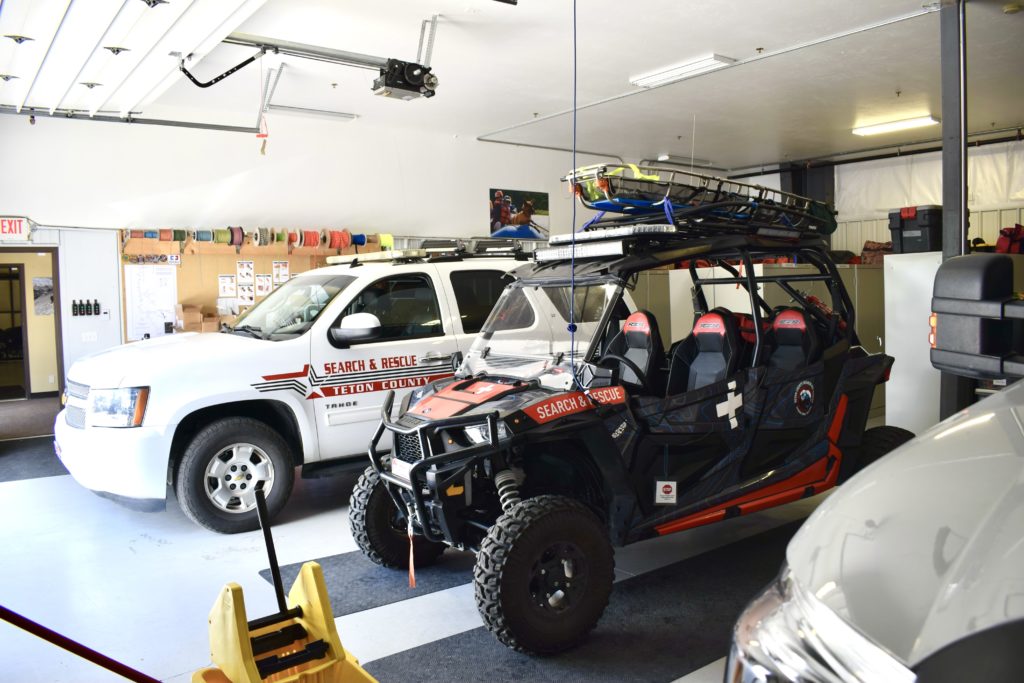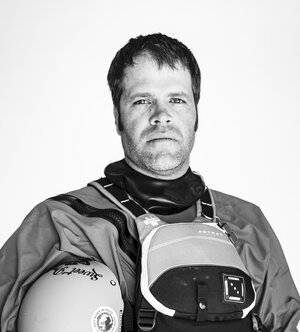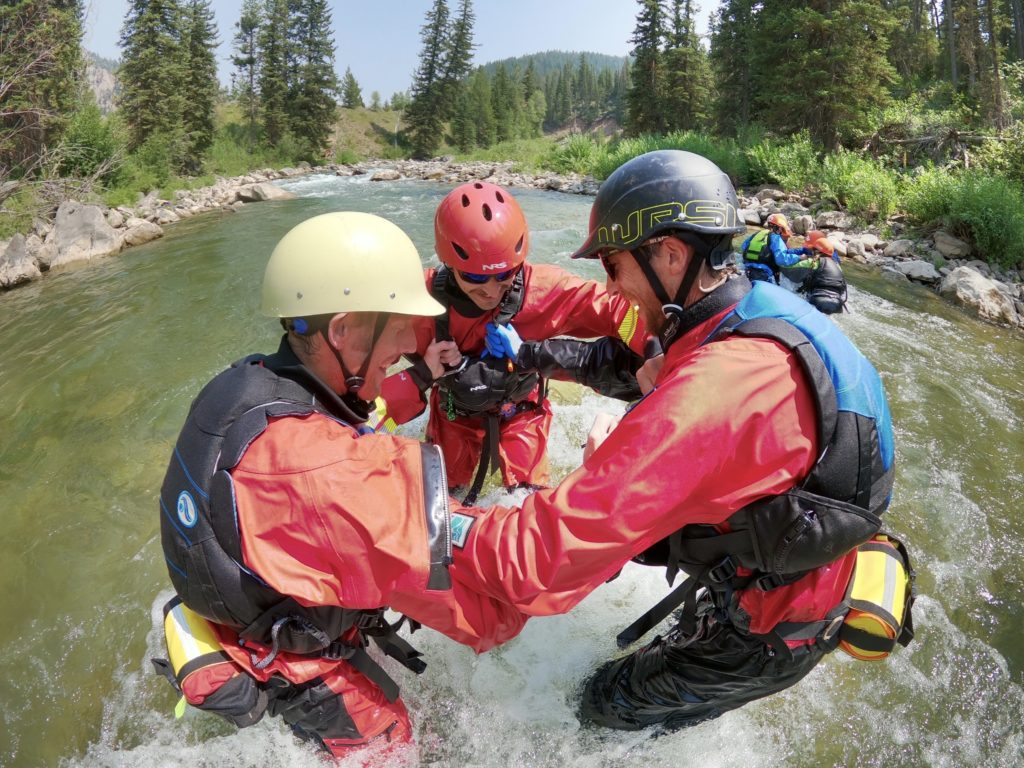The Teton County Search and Rescue (TCSAR) hangar off Highway 22 is filled with almost every toy imaginable: Multiple pickup trucks, some with jet boats attached to the back, all-terrain 4-wheelers parked next to snowmobiles and a helipad the next room over. On a recent Tuesday, though, the new TCSAR class is learning about something a little more simple.
The ten trainees are getting a crash course in what’s called patient packaging. If someone is seriously injured in the backcountry, and can’t walk out, they might get tied onto a back brace and wheeled out to safety. It might take several hours.
The new volunteers gather around Anthony Stevens, training advisor for the team, and KC Bess, TCSAR’s membership advisor. The newbies will keep attending classes like this twice a month until April of next year.

The new volunteers practice patient packaging, a technique used to wheel injured people out of the backcountry to safety, in the TCSAR hangar. (Will Walkey/KHOL)

Being able to rescue a victim from one Teton County’s many raging rivers is an essential skill for any TCSAR volunteer. (Courtesy of Black Fox Rescue Institute)

The TCSAR hangar houses several dozen vehicles, including snowmobiles, jet boats, trucks, vans and more ready to spring into action. (Will Walkey/KHOL)

Anthony Stevens is training advisor for TCSAR and a volunteer since 2015. (Courtesy of TCSAR)
They have all the kind of introductory new class trainings,” Stevens said. “Swiftwater rescue, basic medical, they’ll take a full WFR—Wilderness First Responder—course. They’ll get aviation. How to be a good crew member in the ship.”

KC Bess is management advisor for TCSAR and a volunteer since 2015. (Courtesy of TCSAR)
At the end of all that instruction, the new recruits will become full volunteer team members, on-call ready to drive to the hangar at a moment’s notice if they’re needed on the Snake River, Teton or Togwotee Pass or wherever else someone needs help.
“There’s no written test or skills test. They’re kind of being evaluated. It’s the longest job interview they’ll ever have,” Stevens said.
The new TCSAR trainees come from a range of backgrounds. Some were born and raised here. Others came for a winter season and never left. Pretty much all of them are badass mountaineers, skiers and climbers.

Brook Yeomans, 42, has lived in Jackson since 2000 and teaches at Colter Elementary. (Courtesy of TCSAR/Morris Weintraub)
To get to this point, each trainee went through a months-long interview process that started last winter and whittled 152 applicants down to just 10. Brook Yeomans, a special education teacher at Colter Elementary and father of two, has actively applied several times since 2000. It’s been six years since TCSAR took a new class.
“I guess I just—I wore them down and they’re like, ‘Well, we’re never going to get rid of this guy. Better bring him on the team,’” Yeomans said. “And, you know, I think I will be a good teammate. You know, the amount of respect I have for the whole team and what they do is pretty profound.”
Everyone has their own reasons for joining TCSAR, but a common theme emerged for many of the newcomers: helping people on what could be the worst day of their lives.
“As a climber or a skier, I think that’s really hard, right, to feel like you can have some greater purpose in what can be kind of a narcissistic sport,” said Lauren Funaro, a 29-year-old ICU and emergency room tech at St. John’s Medical Center. “With the skills and with the training I’ve had, especially the medical training, it just feels like I can kind of give back to the community with this unique skill set that I’ve honed.”

Lexie Drechsel, 31, has lived in Jackson for eight years and owns a mobile physical therapy practice. (Courtesy of TCSAR/Morris Weintraub)
“Accidents happen in the mountains, and I don’t want that to keep people from pursuing those adventures and recreations,” said Lexie Drechsel, a 31-year-old physical therapist.
While technical abilities like swiftwater rescue or scaling the Grand are critical, Bess said soft skills and selflessness are actually the most important characteristics of a good TCSAR volunteer. Successful team members have to be adaptable and someone whom other people want to work with.
“There wasn’t a specific skill set [we were looking for]. It was primarily people who were going to be good team players who came with a diverse background and were strong and able to learn quickly. That was some of the main things we’re looking for,” Bess said.
Back at the training center, adaptability was on full display when a call came in during KHOL’s visit for a drift boat that had tipped over on the Snake River. Bess and Stevens quickly paused training and sprang into action. Suddenly, a relatively quiet morning turned into organized chaos.
For the trainees, it was also the first time they watched the team actually assemble for a real call.

Lauren Funaro, 29, moved to Jackson six years ago “to ski for a winter.” (Courtesy of TCSAR/Morris Weintraub)
“I watched some, you know, instant leadership from many members of the team. You know, their incident commander was established so quickly,” Funaro said.
Sadly, that day’s rescue ended with a fatality, despite a rapid response time from TCSAR. A tourist from Alabama drowned. It was a sober reminder for some trainees who said they know it will be hard to respond to tough situations in the places they love to play. Some worry it could ruin the wilderness for them. But, for many new volunteers, bad days in the mountains are exactly what pushed them to join in the first place.

Ian Johnston, 30, is a certified public accountant and avid skier. He moved to Jackson when he was 4. (Courtesy of TCSAR/Morris Weintraub)
“Basically, we were out skiing off Cody Peak one day, just me and a buddy, and heard a cry for help across the slope,” said Ian Johnston, a 30-year-old accountant. “And we were kind of the first ones that ended up getting there just by happenstance.”
“So, I was the one that placed the call. And the heli came in, and unfortunately it was a member outside of our party that had a slip and fall from a pretty significant height. And he did not make it. And that was kind of my first time rescuing in the Tetons,” Drechsel said.
“I’ve had things go very, very wrong in the mountains and had a really tragic accident on Mount Moran and lost two of my best friends. [Teton County] Search and Rescue was there for me, and there for them. And I just was just blown away by how much they did. How professionally they did it. So, this is just an amazing opportunity for me to give back to them and do everything I can for the team,” Yeomans said.
The camaraderie and awe radiated from the new recruits in the hangar after TCSAR turned on their sirens and headed towards the Snake. Most current volunteers say it takes about four years for new trainees to feel fully comfortable in any rescue situation. For the new class of ten, the next few months are just the beginning. And they wouldn’t have it any other way.
More information about Teton County Search and Rescue, and the other new volunteers, is available at tetoncountysar.org.

The new recruits have been training together since April 2021. (Courtesy Black Fox Rescue Institute)






